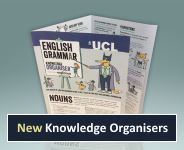Explanation
A classification of clauses into four grammatical types: declarative, interrogative, imperative and exclamative (sometimes called sentence moods or sentence functions). Each type is typically associated with a different discourse function: statement, question, directive (or command), and exclamation, respectively. The National Curriculum uses only the latter set of terms for both structure and function.
Englicious contains many resources for English language in schools, but the vast majority of them require you to register and log in first. For more information, see What is Englicious?

